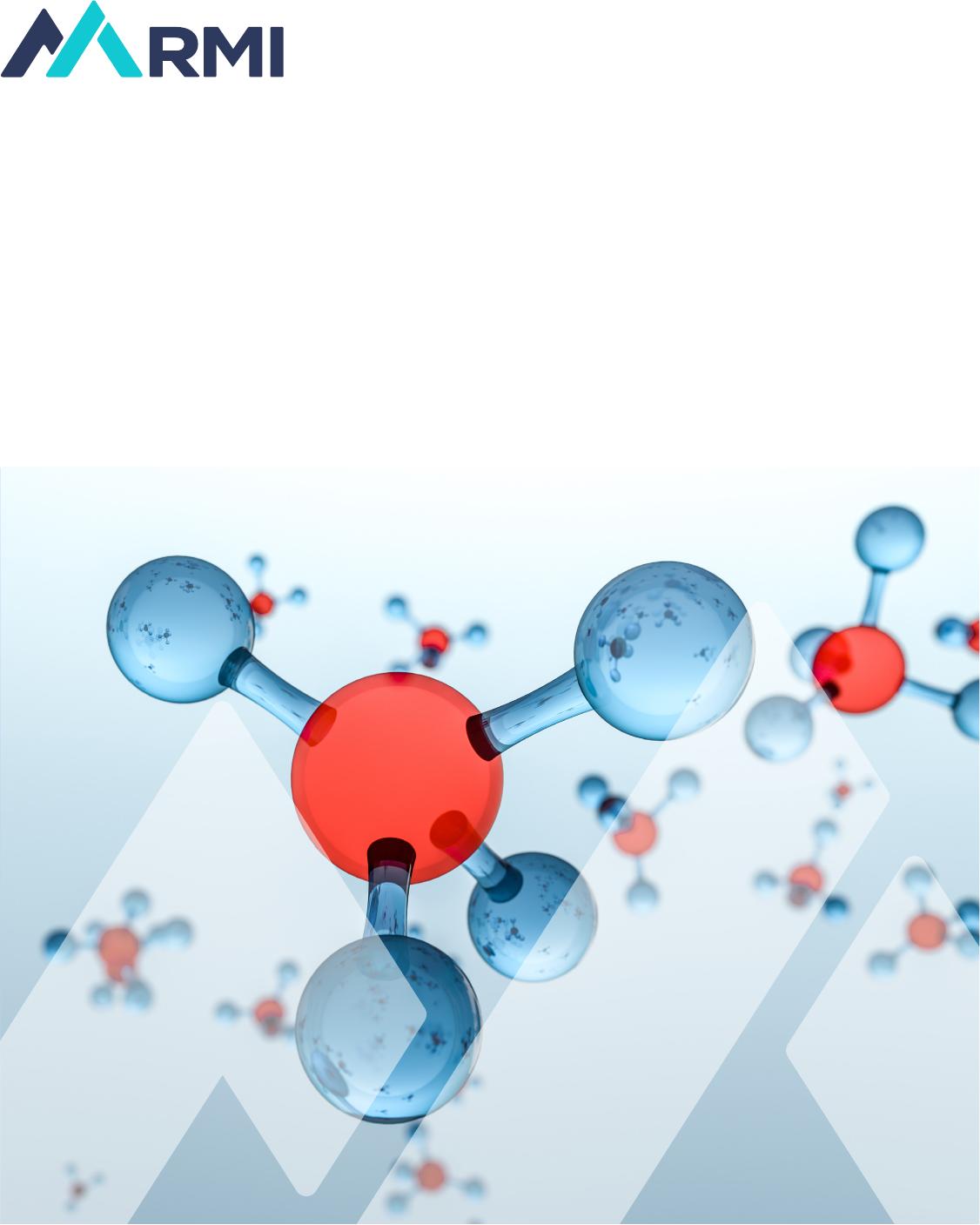ReportSeriesonMethaneEmissionsControlMethaneEmissionsMitigationApproachesacrossMultipleDimensionsinChina'sEnergySectorExecutiveSummaryES/December2023AboutRMIRMIisanindependentnonprofit,foundedin1982asRockyMountainInstitute,thattransformsglobalenergysystemsthroughmarket-drivensolutionstoalignwitha1.5°Cfutureandsecureaclean,prosperous,zero-carbonfutureforall.Weworkintheworld’smostcriticalgeographiesandengagebusinesses,policymakers,communities,andnongovernmentalorganizationstoidentifyandscaleenergysysteminterventionsthatwillcutgreenhousegasemissionsatleast50percentby2030.RMIhasofficesinBasaltandBoulder,Colorado;NewYorkCity;Oakland,California;Washington,D.C.;andinBeijing,People’sRepublicofChina.MethaneEmissionsMitigationApproachesacrossMultipleDimensionsinChina’sEnergySectorrmi.org/2AuthorsandAcknowledgmentsAuthorsMinhuiGao,YihanHao,TingLi,WeiWangOtherContributorsQiangLiu,XinSuAuthorsarelistedalphabeticallybylastname.AllauthorsarefromRMIunlessotherwisenoted.ContactWeiWang,wwang@rmi.orgCitationRMI,MethaneEmissionsMitigationApproachesacrossMultipleDimensionsinChina’sEnergy,Sector,RMI,2023,https://rmi.org/insight/methane-emissions-mitigation-approaches-across-multiple-dimensions-in-chinas-energy-sector/AcknowledgmentsWewouldliketoexpresssincerethankstothefollowingexpertsfortheirinsightandcomments:FeiTeng,ProfessorandDeputyDirector,InstituteofEnergyandEnvironmentalEconomics,TsinghuaUniversityXinXu,DeputyDirector,EnergySecurityResearchInstitute,ChinaCoalInformationInstitute,MinistryofEmergencyManagementQianLiu,Director,DepartmentofResearch,theSustainabilityStandardsResearchCenter,CentralUniversityofFinanceandEconomicsJunlianGao,AssociateProfessor,DepartmentofManagementScienceandEngineering,ChinaUniversityofMiningandTechnologySpecialthankstotheGlobalMethaneHubThecontentsofthisreportdonotrepresenttheviewsoftheaboveexpertsandinstitutions,aswellasthoseoftheprojectproponents.MethaneEmissionsMitigationApproachesacrossMultipleDimensionsinChina’sEnergySectorrmi.org/3ExecutiveSummaryMethane(CH4)isthesecondmostabundantgreenhousegasaftercarbondioxide(CO2).Ithascontributedtoover30%ofthecurrentriseinglobaltemperaturesincetheindustrialrevolution.Theinternationalcommunityhasreachedaconsensustotacklemethaneemissions,leadingtomultilateralandbiliteralcooperationonmethanemitigation.TheGlobalMethanePledge,initiatedbytheUnitedStatesandtheEuropeanUnionduringthe26thUNClimateChangeConferencein2021,hasover150participatingcountries,pledgingcollectiveeffortstoachievea30%reductioninglobalmethaneemissionsby2030,relativeto2020levels.Recently,ChinaandtheUnitedStatesdecidedtooperationalizetheWorkingGrouponEnhancingClimateActioninthe2020s.TheWorkingGroupwillfocusontheareasofcooperationthathavebeenidentifiedintheSunnylandsStatementandtheGlasgowDeclaration,includingonmethane.Overtheyears,Chinahasbeenactivelyengagedinmethanemitigation,implementingarangeofpoliciesandeconomicmeasurestocurbtherapidgrowthofmethaneemissions.InNovember2023,theChinesegovernmentmadepublicthenationalactionplandedicatedtomethaneemissionscontrol,addressingtoimproveemissionsmonitoringandsupervisionsystemsformethane,andoutliningmitigationmeasuresinthefieldsofenergy,agriculture,waste,andwastewatertreatment.Thisactionplan,servingasChina’sfirstnational-leveldocumentdesignedformethaneemissionscontrol,willfurtheraccelerateitsmethanemitigationefforts.China’smethaneemissionsoriginateprimarilyfromactivitiesrelatedtofossilfuelproductionanduse,ricecultivation,livestock,andwastemanagement.Amongthesesources,theenergysectorconstitutesthelargestcontributor,accountingfor46%ofthetotalmethaneemissionsinChina.iComparedwithothersectors,theenergyindustryhasmorematuremitigationtechnologies,makingittheprimaryfocusatthecurrentstage.Currently,Chinastillfacesthreemajorchallengesinmethaneemissionscontrolwithintheenergysector:•ThemajorityofmethaneemissionsinChina’senergysectorstemfromcoalproduction.AsthetotalfossilenergyconsumptioninChinahasnotyetpeaked,thereisaneedtoeffectivelymanageandbalanceenergyproduction,energyconsumptionandmethanemitigation.•Unevendevelopmentofmitigationtechnologiesintheenergyindustry,coupledwithinsufficientcost-effectivenessformajoremissionssources,makesitchallengingtoattractinvestmentformitigationprojects.•Apartfrompolicyandtechnologicalsupport,methanemitigationrequiresconcreteactionsfromthecoalindustryandoilandgascompanies.GreaterawarenessandincentivesarecrucialtocatalyzeinitiativeswithinChineseenergyenterprisesandrelatedindustries.Toaddressthepreviouslymentionedchallenges,RMIproposesmeasuresacrossfivedimensionstoacceleratemethanemitigationinChina’senergysector.Theenergysectorshouldoptimizeenergyproductionandconsumptionbyacceleratingenergytransitionandestablishingprocurementprinciples,therebymaximizingthesynergisticeffectofenergytransitiononmethaneemissionsreduction.Itshouldenhancetheeconomicviabilityandapplicabilityofmitigationtechnologiesthroughmarketmechanismstopromoteprojectconstructionandfullyrealizetheclimatevalueofmethanereduction.Itshouldbreakdowninformationbarriersthroughimprovedinformationdisclosure.Itshouldalsoboostmethanegovernancethroughincreasedinternationalcooperation,facilitatingcross-sectorcomparisonsandtriggeringcompaniestoactivelyengageinmitigationeffortsandenhancingChina’sparticipation,contributionandleadershipintheprocessofglobalclimategovernance.iInternationalEnergyAgency(IEA),“GlobalMethaneTracker2023,”February2023,https://www.iea.org/reports/global-methane-tracker-2023.MethaneEmissionsMitigationApproachesacrossMultipleDimensionsinChina’sEnergySectorrmi.org/4Dimension1:EnergyTransitionThesubstantialdomesticdemandforcoal,oil,andnaturalgasproductshasdrivenupstreamactivitiesrelatedtotheextraction,processing,andtransportationoffossilenergysources,resultinginsignificantCH4emissions.TheenergyconsumptionstructureacrossvarioussectorsinChinaisacrucialfactoraffectingCH4emissions.Intheprocessofenergyprocessingandconversion,activitiessuchascoal-basedelectricitygenerationandcokeproductioncontributesignificantamountsofenergymethaneemissions,withcurrentlevelsat47%and17%,respectively.Attheend-uselevel,existingproductionprocessesinthesteel,chemicals,andcementindustriesnecessitatesubstantialfuelandrawmaterialconsumption,whichcontributetomethaneemissionswithpercentagesof21%,14%,and8%,respectively,makingtheindustrialsectorthelargestcontributor.Concurrently,theresidentialandtransportationsectors,drivenbyheating,cooking,andtransportationdemands,alsoconsumesignificantquantitiesoffossilfuels,contributing13%and5%tomethaneemissions,respectively(seeExhibit1).Exhibit1FlowChartofMethaneEmissionsfromFossilFuelProductionCH4fromCoalMiningThermalPowerProductionCokingCH4fromGasSystemDirectUseFinalConsumptionCH4fromOilSystemofCoalProductionHeatSupplyNaturalGasLiqueficationDirectUseofNaturalGasOilRefiningandCoal-to-LiquidsDirectUseofOilEnergyProcessingandConversionRMIGraphic.Source:IEA,https://www.iea.org/reports/global-methane-tracker-2023;NationalBureauofStatistics,http://www.stats.gov.cn/sj/ndsj/2022/indexch.htm;RMIanalysisMethaneEmissionsMitigationApproachesacrossMultipleDimensionsinChina’sEnergySectorrmi.org/5Transitionmeasuresinkeyindustries,particularlytheimplementationoflow-carbontechnologiesinthepower,steel,andchemicalsindustries,havethepotentialtodirectlyreduceCO2emissionsandtocollaborativelydecreasemethaneemissionsfromtheproductionsideoffossilfuels.AccordingtoestimatesbyRMI,by2060,measuresinsixmajorsectors(i.e.,electricity,steel,chemicals,cement,transportation,andresidential)areexpectedtocontributetoa61%reductioninenergy-relatedmethanecomparedwiththe2020baseline.Notably,thepowerandsteelindustries,whicharemajorcoal-consumingsectors,willhavethemostsignificantimpact,drivingmethanereductionsof41%and12%,respectively.Duetothesubstantialshort-term(pre-2030)demandforfossilenergyinvariousindustries,itisprojectedthatdomesticcoalconsumptionwillpeakandslowlydeclineby2030.Thecontributiontomethanereductionfromthetransitionmeasuresinthesixmajorkeyenergy-consumingindustriesby2030isestimatedtobeonly7%.Thisimpliesthatadditionaleffortswillstillberequiredtocontrolmethaneintheshortterm,includingoptimizingexistingresources,promotingresearchandapplicationofkeytechnologies,encouragingcorporateaction,andenhancinginformationtransparency.Dimension2:ProcurementPrinciplesMethaneemissionsfromtheproductionofcoal,oil,andnaturalgasvarysignificantlybetweenproductionregionsduetogeologicalconditions,extractionmethods,implementationofmitigationtechnologies,anddifferingmanagementlevels(seeExhibit2).Whilemeetingtheoverallconsumptionoffossilfuels,shiftingconsumptiontowardproducingregionswithloweremissionsintensitycanhelpreducemethane.Exhibit2MethaneEmissionsIntensityinMajorFossilEnergyProductionSitesEmissionsIntensity(kgCH4/tonesofcoalequlvalent)050100FuelTypeCoalOilNaturalGasRMIGraphic.Source:GlobalEnergyMonitor,https://globalenergymonitor.org/projects/global-coal-mine-tracker/;RMIanalysisMethaneEmissionsMitigationApproachesacrossMultipleDimensionsinChina’sEnergySectorrmi.org/6Withtheongoingtrendofenergytransition,China’scoalconsumptionisexpectedtocontinuallydecrease,resultinginanincreasedpotentialforproductionlayoutoptimization.Underthesecircumstances,theabilitytomonitorandidentifythemethaneemissionsperformanceofvariousminingregionscanserveasatooltoguidemethanemanagementwithincoalenterprises.Inthiscontext,ifcoalconsumersestablishdedicatedprocurementprinciplesbasedonmethaneintensityandprioritizethepurchasefromregionswithlowerintensity,theycansignificantlyinfluencemethaneemissionsthroughtheirconsumptionactivities.AccordingtoRMIestimates,implementingthelow-intensityprocurementprincipleinmetallurgicalcoalmines,asopposedtoprioritizinghigh-intensitycoalmines,canleadtoasubstantial27%reductioninmethaneemissions.Similarly,forthermalcoalmines,therecanbeanotable76%differenceinmethaneemissionsbetweenlow-intensityandhigh-intensityprocurementscenarios.Chinahasthepotentialtoeffectivelyleverageitsabundantcoalresources(seeExhibit3).Bydrivingchangesincorporateconsumptionpreferencesandcontinuallyadvancingtheoptimizationofcoalresourcesbasedonmethaneintensity,supportedbybothregionalandnationalpolicies,Chinacaneffectivelypromoteemissionsreductionwithinthecoalindustry.Exhibit3MethaneEmissionsfromChina’sCoalMinesunderDifferentProcurementPrinciples302030MetCoal2030ThermalCoalThermalCoalCapacityDemandDemandMetCoalCapacityCoalMineCH4Intensity(kgCH4/t)2520MetCoalCH4MetCoalCH4EmissionsEmissionsunderundertheHigh-Intensity15PrincipleScenariotheLow-IntensityThermalCoalCH4EmissionsPrincipleScenarioundertheLow-IntensityPrincipleScenario10ThermalCoalCH4EmissionsundertheHigh-IntensityPrincipleScenario5005001,0001,5002,0002,5003,0003,5004,000CoalMineCapacity(Mt)RMIGraphic.Source:GlobalEnergyMonitor,https://globalenergymonitor.org/projects/global-coal-mine-tracker/;JulianGaoetal.,https://iopscience.iop.org/article/10.1088/1748-9326/ac38d8;RMIanalysisInadditiontodomesticregulations,whenprocuringimportedfossilfuels,ChinahasthepotentialtoleverageitsinfluencebyrequiringsupplierstofurnishdatathatverifiestheiralignmentwithChina’sintensityandpolicycompliancestandards.Thisapproachcouldpotentiallyincentivizefossilfuel–producingnationstointensifytheireffortstoreducemethaneemissions.AccordingtoRMIestimates,byimposingChina’smethaneemissionsintensityasaconstraintcriterionforfossilfuelimports,providedimportvolumesremainconstant,theimplementationofalow-intensityprinciplecouldyielda30%reductioninmethaneemissionsattributedtoimportedfossilfuels.Fromacorporateperspective,Chineseenterprisesengagedinfossilfuelconsumptioncanemployemissionscertificationplatformsastoolstofacilitatetheselectiveprocurementoflow-methaneintensityproducts,consequentlyaffectingareductioningreenhousegasemissionsthroughouttheirupstreamsupplychains.MethaneEmissionsMitigationApproachesacrossMultipleDimensionsinChina’sEnergySectorrmi.org/7Dimension3:MarketMechanismsThemethanegeneratedduringtheundergroundcoalminingprocessisapivotalfocusformethanereductionwithinthecoalindustryandcanbeeffectivelymitigatedthroughtheimplementationofrecoveryandutilizationtechnologies.Keyemissionsreductiontechnologiesincludethosetargetinglow-concentrationcoalminemethane(CMM)andventilationairmethane(VAM).Duetotheirsuboptimaleconomicviability,additionalincentivemeasuresarenecessarytodrivetheconstructionandoperationoftheseprojects.China’sCertifiedEmissionReduction(CCER)schemeoffersavaluablesupplementtothenationalemissionstradingsystem.ByincludingCMMandVAMprojectswithintheCCERmarket,projectoperatorscanobtainverifiedemissionsreductionsandtradethemwithparticipantsinthecarbonmarket,therebygainingdirecteconomicbenefits,asshowninExhibit4.Exhibit4ApplicationofCoalSectorMethaneCCERProjectintheCarbonMarketCCERVerificationandTradeCCERActualEmissionsCreditsPurchasedfromCarbonMarketBaselineEmissionReductionsInitialEmissionsQuotaProjectScenarioEmissionsCoalSectorMethaneUtilizationProjectCarbonMarketComplianceCompanyRMIGraphic.Source:RMIanalysisIntheabsenceoftheCCERmarket,themethaneabatementcostsforVAMutilizationandVAM-CMMcomprehensiveutilizationareapproximately1,400RMBpertonofmethaneand300RMBpertonofmethane,respectively.WhentheseprojectsparticipateintheCCERmarket,costsgraduallydecreaseastheCCERtransactionpricecontinuestorise.WhentheCCERpricereaches52RMBpertonofcarbondioxideequivalent(CO2e),bothVAMutilizationprojectsandVAM-CMMmixedutilizationcanbeachievedatnonetcost(seeExhibit5).In2022,theaveragenationalcarbonpriceinChinawas55RMBpertonofCO2e.Thisindicatesthatthecarbonmarketcanserveasafoundationaldriverforpromotingmethaneutilizationinthecoalsector.Lookingahead,asmoreindustriesareintegratedintothecarbonmarketandcarbonquotasbecomemorestringent,carbonpriceswillrise.This,inturn,willdriveanincreaseinCCERpricesandcreateadditionalprofitforCMMutilizationprojects.MethaneEmissionsMitigationApproachesacrossMultipleDimensionsinChina’sEnergySectorrmi.org/8Exhibit5CH4AbatementCost(RMB/tCH4)ImpactofCCERPricesontheEconomicViabilityofDifferentMethaneUtilizationProjects2,0001,000CCERPrice=52RMB/tCO2e020406080100120-1,000-2,000-3,000-4,0000CCERPrice(RMB/tCO2e)VAMUtilizationVAM-CMMMixedUtilizationLow-ConcentrationCMMPowerGenerationHigh-ConcentrationCMMPowerGenerationNote:Gasconcentrationthresholdsforemissionsreductiontechnologiesareasfollows:VAMutilization:CCH4<0.75%VAM-CMMmixedutilization:VAMCCH4<0.75%,CMMCCH4<8%Low-concentrationCMMpowergeneration:8%≤CCH4<30%High-concentrationCMMpowergeneration:CCH4≥30%Thisassumesthatlow-andhigh-concentrationCMMpowergenerationprojectsarenotparticipatingintheCCERmarket.RMIGraphic.Source:RMIanalysisAsmoresectorsareprogressivelyincorporated,thenationalcarbonmarketwillencompassapproximately8billiontonsofCO2emissions.Atthatpoint,theCCERmarket’sscaleisexpectedtoreach400milliontonsofCO2e.AccordingtoRMIestimates,by2030,CCERprojectsrelatedtoCMMandVAMareprojectedtoexceed14billionRMBintotalscale,covering30%ofthetotalCCERdemand(seeExhibit6).Thiscontributionisexpectedtoresultina21%reductioninmethaneemissionswithinthecoalindustry.MethaneEmissionsMitigationApproachesacrossMultipleDimensionsinChina’sEnergySectorrmi.org/9Exhibit6CCERProjectsScaleforCMMandVAMUtilization2040%CoalSectorMethaneCCERMarketSizeasaPercentageofTotalCCERDemandCoalSectorMethaneCCERMarketSize1530%(RMBBillion)1020%510%0202420252026202720282029020232030CoalSectorMethaneCCERMarketSize%ofTotalCCERDemandRMIGraphic.Source:RMIanalysisDimension4:InformationDisclosureInformationdisclosurerelatedtomethaneemissionsprovidesseveralbenefits,includingenhancedcorporateperformance,reducedregulatoryrisks,supportforgovernmentdecision-making,increasedsocietalawareness,andthefoundationforcorporateparticipationinmarketmechanismsanddeeperinternationalcooperation.InChina,coalcompaniescurrentlyhavelimitedmethaneemissionsdisclosure.Onlyafewcompanieshavesharedinformationonmethanerecoveryandutilization,leavingsubstantialgapsindisclosure.Incontrasttocoalcompanies,Chineseoilandgascompanieshaveahigherlevelofinformationdisclosure.LargeoilandgascompaniesinChinahavesetemissionsreductiontargetsandaredisclosingtheirprogressthroughenvironmental,social,andgovernance(ESG)reportsandinternationalplatforms.Comparedwithinternationalcounterparts,Chinesecompaniescouldfurtherimprovethelevelofdetailintheirdisclosures.(seeExhibits7and8).RMIsuggeststhatChineseenergycompaniesenhancetheirtransparency,particularlyconcerningdisclosureinemissionsreductiontargets,emissionsdata,andemissionsreductionactions(seeExhibit9).MethaneEmissionsMitigationApproachesacrossMultipleDimensionsinChina’sEnergySectorrmi.org/10Exhibit7MethaneDisclosureStatusofChineseCoalandOilandGasCompanies19%100%CompaniesUndertakingClimateDisclosurethrough81%CompanyWebsites35%CompaniesUndertaking44%ClimateDisclosure12%44%throughESGReportandAnnualReports50%CompaniesUndertaking8%ClimateDisclosurethroughInternationalPlatforms50%OilandGasCompaniesthatDiscloseInformationRelatedtoMethaneMitigationCoalCompaniesthatDiscloseInformationRelatedtoMethaneMitigationCompaniesthatDoNotDiscloseInformationRelatedtoMethaneMitigationRMIGraphic.Source:RMIanalysisMethaneEmissionsMitigationApproachesacrossMultipleDimensionsinChina’sEnergySectorrmi.org/11Exhibit8MethaneEmissionsDisclosureComparisonBetweenDomesticandInternationalEnergyCompaniesCH4emissionsTotalCH4emissionsandCH4Provideadditionalinformationreductiontargetsintensitywithdetaileddataonbestpractices,aswellas(totalreductionbasedinvestmentinresearchandandintensitybased)bysource,withcomparisonsdevelopmentofmitigationtechnologiesQuantitativeCH4topreviousyearsemissionsreductiontarget(totalreductionTotalemissionsandDetailedelaborationoftheintensity,withcomparisonsscopeofmitigationactions,orintensity)technologyimplementation,topreviousyearsandprogressStatusofDisclosureQualitativeCH4ReportonlythetotalCH4Providedata-supportedmitigationtargetsemissionsorintensityinformationontheimplementationofreductiontechnologiesIncludedunderoverallclimateCH4emissionsarereportedProvideinformationonasCO2einScope1emissionsmitigationactionswithouttargets,noseparateCH4andareincorporatedintothemitigationtargetsdetaileddatatotalemissionsNotargetsettingNodisclosureonCH4dataNodisclosureonmitigationeffortsTargetSettingEmissionsDataMitigationActionsInternationalChineseOilandChinesecoalBestPracticesGasCompaniesCompaniesRMIGraphic.Source:RMIanalysisMethaneEmissionsMitigationApproachesacrossMultipleDimensionsinChina’sEnergySectorrmi.org/12Exhibit9RecommendedInformationDisclosureonMethaneEmissionsforChineseCoalandOilandGasCompaniesCoalCompaniesOilandGasCompanies1.Targets1.Targets•TotalReductionTargets:Theproportionor•TotalReductionTargets:Theproportionoramountbywhichmethaneemissionsshouldamountbywhichmethaneemissionsinthebereducedinthetargetyearcomparedwithtargetyearshouldbereducedcomparedwiththebaselineyear.thebaselineyear.•IntensityTargets:Methaneemissionsperton•IntensityTargets:Methaneemissionsperofcoalproduced,furthercategorizedintounitofnaturalgasproductionorgassales,thermalcoalandcokingcoal.expressedasapercentage.2.EmissionsData2.EmissionsData•Totalmethaneemissionsforthetarget•Totalmethaneemissionsforthetargetbaselineyear,reportingyear,andhistoricalbaselineyear,reportingyear,andhistoricalyears(ifavailable).years(ifavailable).•Detailedmethaneemissionsbreakdown•Detailedmethaneemissionsbreakdowncategorizedbyemissionssources(e.g.,categorizedbysources(upstream,refining,undergroundmining,surfacemining,petrochemicals)oremissionstypes(venting,postminingactivities,abandonedcoalmines).flaring,fugitiveemissions).•Boundarydefinitionsandmethodologies•Boundarydefinitionsandmethodologiesusedforaccounting.usedforaccounting.3.Actions3.Actions•Participationorinitiationofdomesticand•Participationorinitiationofdomesticandinternationalmethanereductionalliances,internationalmethanereductionalliances,alongwithcontributionsandprogressmade.alongwithcontributionsandprogressmade.•Specificcasesofemissionsreduction•Specificcasesofemissionsreductionactivities,includingdetailsofthecoalminesactivities,includingdetailsoftheoilandgasinvolved,thetypeofmethaneemissionsfieldsandfacilitiesinvolved,thetechnologiestargetedforrecoveryandutilization(e.g.,employed,descriptionsofthefrequencyandVAM,CMM),informationonthetechnologiesscopeoftechnologyimplementation,andtheemployed,andtheamountofmethaneamountofmethanerecoveredandutilized.recoveredandutilized.•Supportforgovernmentinitiativesrelatedto•Supportforgovernmentinitiativesrelatedtomethanereduction,participationinrelevantmethanereduction,participationinrelevantactivities,andachievedresults.activities,andachievedresults.•Investmentinmethanereductionprojects,•Investmentinmethanereductionprojects,fundingformethanereductiontechnologyfundingformethanereductiontechnologydevelopment,andcostsrelatedtodevelopment,andcostsrelatedtoutilizationprojects.utilizationprojects.MethaneEmissionsMitigationApproachesacrossMultipleDimensionsinChina’sEnergySectorrmi.org/13Dimension5:InternationalCooperationInternationalcollaborationplaysapivotalroleinenhancingChina’scapabilitiesformitigatingmethaneemissions,curbingemissionslinkedtoimportedenergyresources,drivingdomesticactions,andbolsteringChina’sstandingininternationaldiscussions.Chinahasbeenactivelyinvolvedininternationalmethaneemissionsreductioneffortsoverthepastdecade.Nevertheless,thereremainssubstantialpotentialforcorporateengagement.Intherealmofinternationalemissionsreductionalliances,theEUandtheUnitedStatesareleaders,boastingsignificantparticipationinalliancessuchastheOilandGasClimateInitiative(OGCI),theOilandGasMethanePartnership(OGMP),andtheMethaneGuidingPrinciples(MGP),accountingfor58%,79%,and68%,respectively(seeExhibit10).Moreover,asignificantportionofcompaniesparticipatinginmultipleinternationalalliancesbelongtoEUandUScompanies,comprisingtwo-thirdsofthetotal.Inthesealliances,fiveChinesecompanieshavemadededicatedefforts,includingoneoilandgascompanyandfoururbangascompanies.Althoughmanycompanieshavejoinedinternationalalliancesandactivelyparticipatedintheirendeavors,thereisstillampleroomtoincreasetheoverallparticipationofChineseenterprise.Exhibit10ParticipationofCompaniesinInternationalMethaneEmissionsReductionAlliances69209341134EUUnitedStatesChinaOGMPMid-DownstreamCompanyMGPMid-DownstreamCompanyOGCIUpstreamCompanyOGMPUpstreamCompanyMGPUpstreamCompanyRMIGraphic.Source:OGCI,https://www.ogci.com;OGMP,https://ogmpartnership.com/our-member-companies/;MGP,https://methaneguidingprinciples.org;RMIanalysisMethaneEmissionsMitigationApproachesacrossMultipleDimensionsinChina’sEnergySectorrmi.org/14Internationalcooperationinmethaneemissionsreductioninthecoalindustryprimarilyfocusesongasrecoveryandutilizationprojectconstructionandtechnologyexchange.Currently,thereisnounifiedglobalemissionsreductiontarget.Thelevelofinternationalcollaborationonmethanemitigationamongcoalenterprises,includingthoseinChina,remainslimited.Chinahasextensiveexperienceinmethanemitigationwithinthecoalsectorandsignificantreductionpotential.DedicatedmechanismsformethaneemissionsreductioncooperationshouldbeestablishedamongChineseandglobalenterprises.Inthefuture,initiativesliketheMetcoalMethanePartnership,proposedundertheleadershipofinstitutionsliketheUnitedNationsEconomicCommissionforEurope,canfacilitateChinesecoalenterprises’participationininternationalcollaboration,providingaccesstotechnicalsupport,enhancingemissionstransparency,andcreatingadvantagesinproductsales.RecommendationstoPromoteMethaneEmissionsReductionMethaneemissionscontrolisasystematicundertakingthatrequirescomprehensiveandholisticconsideration.China’senergyindustryhastremendouspotentialandadvantagesformethaneemissionsreduction.Whileensuringenergysecurity,itisessentialtofocusonpromotingmethaneemissionsreductioninkeyindustriesbasedonthedevelopmentalcharacteristicsofeachstageinChina.Inthisregard,RMIproposesfivekeyrecommendationsforChina’senergysectortoboostmethaneemissionscontrol.1.ComprehensiveEnergyTransition:Acomprehensivepromotionofenergytransitionhasadirect,long-term,andprofoundimpactonmethanereductionwithintheenergysector.Whilesafeguardingenergysecurityandeconomicandsocialdevelopment,Chinashouldpushforlow-carbontransitionsinmajorfossilfuel–consumingindustrieslikepower,steel,transportation,andtheresidentialsector.Thisalsoinvolvesreducingfossilfuelconsumption,thusmitigatingmethaneemissionsgeneratedduringfossilfuelproduction.Inthepowersector,wesuggestastrongfocusondevelopingrenewableenergysourcessuchaswind,solar,hydro,biomass,andgeothermalenergytoreducedependenceonandutilizationoffossilfuels.Forthesteelindustry,werecommendthepromotionofshort-processelectricarcfurnacesteelproductionusingscrapsteel,hydrogenmetallurgy,andbiomassmetallurgytechnologiestoreducecokingcoaldemand.Inthetransportationsector,expeditingtheelectrificationofroadtransportation,especiallyinheavy-dutytransport,andencouragingalternativeslikehydrogenandbiofuelstoreplacetraditionalfossilfuelswilldecreasepetroleumdependence.Intheresidentialsector,wesuggestpromotingcoal-to-electricitytransitioninruralareas,maximizingtheuseofrenewableresourceslikebiomass,andreducingscatteredcoalusage.Inurbanbuildings,weencouragetheapplicationofheatpumpstoreducenaturalgasdemandduetoheatingrequirements.2.PromoteLowMethaneIntensityProcurementPrinciples:Werecommendintroducingprocurementprinciplesforfossilfuelsthatincorporatemethaneemissionsstandards.Wealsosuggestestablishingfuelpurchaseprincipleswithmethaneemissionsintensityasoneofthekeycriteria,prioritizingtheprocurementoffuelswithlowemissionsintensity.Thisapproachaimstostimulateemissionsreductionsontheproductionsidethroughconsumerbehavior,enhanceupstreammanagementoffossilfuelproducts,andencouragetheoptimizationofenergyresources.Additionally,weencouragecreatingamethaneemissionsintensitystandardsystemandawardingpremiumstobusinesseswithhighmethanemanagementstandardsfortheirfuelproducts.Wealsorecommendresearchingandimplementingliquefiednaturalgas(LNG)importmanagementstandardsbasedonmethaneemissionsintensitytobothreduceChina’smethaneemissionsrelatedtoimportedfuelsandencourageemissionsreductionsinLNG-exportingcountries.MethaneEmissionsMitigationApproachesacrossMultipleDimensionsinChina’sEnergySectorrmi.org/153.UseMarketMechanismstoPromotetheConstructionandOperationofCoalSectorMethaneUtilizationProjects:Thekeytoreducingmethaneemissionsinthecoalindustryistoimprovetherecoveryandutilizationoflow-concentrationgasandVAM.Existingtechnologiesarestillinthedemonstrationphaseduetocostconstraints,andincreasingadditionalprojectbenefitsisoneoftheeffectivemeasurestoincentivizebusinessestoadoptcrucialtechnologies.Currently,China’scarbonemissionstradingmarkethasenteredastablephase,andtheCCERmarketisexpectedtobereopened.WerecommendedexpeditingthereviewofthemethodologyforcoalsectormethaneCCERs,acceleratingthedesignandapprovalofgasutilizationprojects,andpromotingtheconstructionandoperationoflow-concentrationCMMandVAMutilizationprojects.Thiswillfurtherdrivemethanereductioninkeyemissionssourcesinthecoalindustry.4.PromoteContinuousEnhancementofEmissionsDisclosureCapabilitiesofEnergyEnterprises:Methaneemissionsdisclosureenhancesacompany’soperationalcapacity,facilitatestherecognitionofclimaterisks,supportsgovernmentdecision-making,andbolsterspublicawarenessofmethanereduction.Chineseenergyenterprisesstillhaveroomforimprovementinmethaneemissionsdisclosure.Asinternationalrequirementsforcorporatetransparencycontinuetorise,Chineseenergyenterprisescandrawoninternationalbestpractices.Theyshouldparticipateinemissionsreportingonmainstreaminternationalplatformsanddisclosetheirmethaneemissionsusingthelatestreportingguidelinesandmethodologies.Chineseoilandgasenterprisesshouldenhancethecontentoftheirreportswithintheexistingframework.Coalenterprisesneedtoestablishindustryconsensusonmethaneemissionsdisclosureanddevelopcommonpracticesandoperatingnorms.5.EncourageEnergyEnterprisestoActivelyParticipateinGlobalMethaneGovernanceandStrengthenIndustryCommunicationandCollaboration:Internationalindustryalliancesplayacrucialroleinmethanereduction.AlliancessuchastheOGCIandtheOGMPhavemembercompaniesthathavedeclaredtheirmethanereductiongoalsandcontrolrequirements.Chineseoilandgasenterprisescanlearnfrominternationalexperiences,settheirownemissionsreductiontargets,andenhancetheirmethanemanagementcapabilities.ChinahasthelargestnumberofCMMrecoveryandutilizationdemonstrationprojectsandadvancedgasutilizationtechnologiesglobally,whichenablesittoleadininternationalcoalindustrymethanereductionefforts.Chinashouldtaketheleadinparticipatingininternationalcoalindustrymethanereductionalliances,increasingitsinfluenceintheformulationofrelevantinternationalrulesandstandards.MethaneEmissionsMitigationApproachesacrossMultipleDimensionsinChina’sEnergySectorrmi.org/16RMI,MethaneEmissionsMitigationApproachesacrossMultipleDimensionsinChina’sEnergySector,RMI,2023,https://rmi.org/insight/methane-emissions-mitigation-approaches-across-multiple-dimensions-in-chinas-energy-sector/RMIvaluescollaborationandaimstoacceleratetheenergytransitionthroughsharingknowledgeandinsights.Wethereforeallowinterestedpartiestoreference,share,andciteourworkthroughtheCreativeCommonsCCBY-SA4.0license.https://creativecommons.org/licenses/by-sa/4.0/.AllimagesusedarefromiStock.comunlessotherwisenoted.RMIInnovationCenter22830TwoRiversRoadBasalt,CO81621www.rmi.org©December2023RMI.Allrightsreserved.RockyMountainInstitute®andRMI®areregisteredtrademarks.



 VIP
VIP VIP
VIP VIP
VIP VIP
VIP VIP
VIP VIP
VIP VIP
VIP VIP
VIP VIP
VIP VIP
VIP